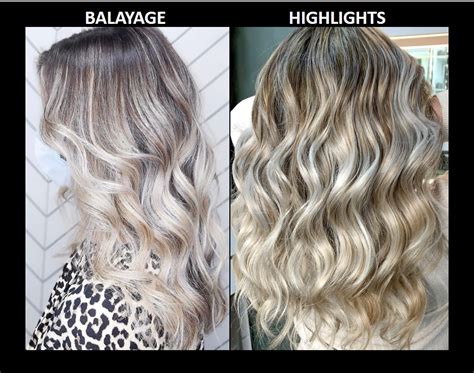Introduction

When it comes to hair coloring, two standout techniques are balayage and highlights. Both methods aim to add depth, dimension, and a sun-kissed glow to your locks, but they differ in key aspects. This comprehensive guide will delve into the 10 crucial distinctions between balayage and highlights, empowering you with the knowledge to make an informed choice for your next hair makeover.
Balayage: In French, “balayage” translates to “to sweep.” This freehand technique involves painting the hair color onto selected sections with a brush or sponge. The color is applied in a gradual, sweeping motion, creating a soft, blended effect.
Highlights: Highlights, on the other hand, are created by isolating small strands of hair and applying the color directly to them. This methodical approach results in more precise, contrasting strands that stand out against the base color.
Balayage: Balayage typically focuses on the mid-lengths and ends of the hair, creating a more natural-looking, sun-kissed effect. The color is applied in subtle strokes, allowing the hair’s natural undertones to show through.
Highlights: Highlights can be placed anywhere on the hair, from the roots to the tips. They can be used to create a range of effects, from subtle brightening to bold, chunky strands.
Balayage: Balayage tends to produce a softer, more gradual transition between the base color and highlights. The blended effect results in a natural, sun-kissed look that enhances the hair’s overall dimension.
Highlights: Highlights create a more noticeable contrast between the base color and the highlighted strands. They can be customized to achieve various levels of intensity, from subtle to dramatic.
Balayage: Balayage requires less frequent touch-ups compared to highlights. The blended nature of the color allows for a longer grow-out period, making it a more low-maintenance option.
Highlights: Highlights need to be retouched more regularly to maintain their vibrancy and prevent roots from becoming noticeable. The frequency of touch-ups depends on the desired level of contrast and thickness of the highlights.
Balayage: Balayage is generally more expensive than highlights due to its time-consuming and freehand nature. The cost can vary depending on the length and thickness of the hair, as well as the experience of the stylist.
Highlights: Highlights are typically less expensive than balayage, as they are more straightforward and time-efficient to apply.
Balayage: Balayage involves less chemical processing compared to highlights, as it does not require bleaching the entire head of hair. However, the repeated application of bleach over time can still lead to some damage.
Highlights: Highlights require more extensive bleaching, potentially causing more damage to the hair’s integrity. Proper care and conditioning are essential to minimize hair damage during and after the highlighting process.
Balayage: Balayage offers greater versatility in creating various looks. It can be used to achieve a range of effects, from subtle ombré to bold, statement-making highlights.
Highlights: Highlights are more versatile in terms of placement, but they can be limiting in creating blended, sun-kissed looks.
Balayage: Balayage typically lasts 3-6 months, depending on the hair’s growth rate and maintenance habits. The gradual transition between the base color and highlights ensures a longer-lasting effect.
Highlights: Highlights require more frequent touch-ups to maintain their vibrancy. The duration of highlights can vary from 8-12 weeks, depending on the specific technique and hair type.
Balayage: Balayage is suitable for all hair types, but it looks particularly flattering on long, thick hair. The blended effect can add volume and dimension to fine or thin hair as well.
Highlights: Highlights are ideal for adding brightness and contrast to darker hair. They can be customized to suit various hair textures and lengths, including shorter hairstyles.
Balayage: Balayage has been a popular hair coloring trend for several years and is here to stay. Its versatility and customizable nature make it a timeless technique that caters to a wide range of hair goals.
Highlights: Highlights have been a staple hair coloring technique for decades but have experienced a resurgence in recent years due to the popularity of chunky, ’90s-inspired highlights.
Balayage and highlights offer distinct approaches to hair coloring, each with its unique advantages and disadvantages. Balayage is ideal for achieving a natural, sun-kissed look with minimal damage while highlights provide precise, contrasting strands that require more frequent touch-ups. Ultimately, the best choice for you depends on your individual hair type, style preferences, and maintenance habits. By understanding the key differences between balayage and highlights, you can make an informed decision and get the hair makeover that perfectly complements your personality and style.
